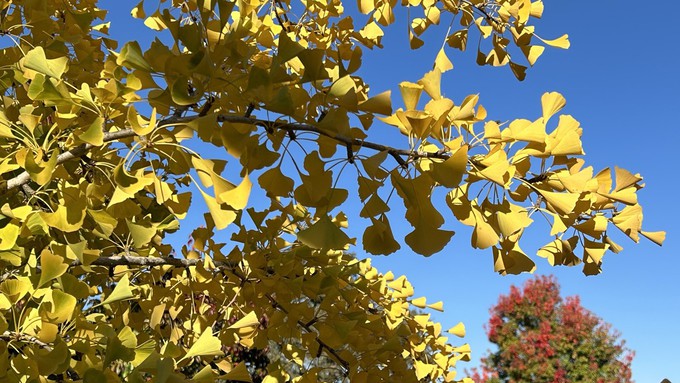
Sacramento fall leaf season looks spectacular; enjoy it while you can

Gingko trees add vibrant splashes of yellow-gold leaves to the Sacramento area's show of fall color. Other street trees add red, orange and crimson. Kathy Morrison
Following sunny and warm days, recent overnight lows in the 40s (and longer nights) have brought out rich rainbow hues of yellow, orange and red. Those pigments are revealed when more darkness and chilly temperatures “turn off” the green chlorophyll in leaves, and the other colors can shine through. With fewer hours of daylight, foliage stops producing chlorophyll and the green pigment disappears.
According to the U.S. Forest Service, the major influencer on autumn color is that growing darkness.
“As days grow shorter, and nights grow longer and cooler, biochemical processes in the leaf begin to paint the landscape with Nature’s autumn palette,” says the forest service, an expert on colorful fall foliage.
Carotenoids (as in carrots) give leaves yellow, orange and brown hues. Anthocyanin, which is stimulated by bright fall light and excess sugars in leaves, is responsible for the reds as well as any bluish or purple tones.
“During the growing season, chlorophyll is continually being produced and broken down and leaves appear green,” the forest service explains. “As night length increases in the autumn, chlorophyll production slows down and then stops and eventually all the chlorophyll is destroyed. The carotenoids and anthocyanin that are present in the leaf are then unmasked and show their colors.”
Some trees are particularly known for their fall display. Maples, for example, reveal their variety by their autumn foliage. Red maples live up to their name with scarlet leaves. Sugar maples become bright orange-red. Black maples turn glowing yellow.
Oaks tend to turn red or russet but some species – such as black oaks – go gold. (And live oaks stay evergreen.) Oaks also tend to hold onto their colorful leaves long after other species have dropped their foliage.
With mature urban forest, Sacramento’s older neighborhoods boast the best color. Look for the gingkos, Chinese pistaches, scarlet maples and liquidambar trees in Land Park, Midtown and East Sacramento. Carmichael, Fair Oaks and Greenhaven also have many brilliant maples, crape myrtles, flowering pears and other autumn stars.
Recent weather boosted Sacramento’s color show.
“A succession of warm, sunny days and cool, crisp but not freezing nights seems to bring about the most spectacular color displays,” says the forest service. “During these days, lots of sugars are produced in the leaf but the cool nights and the gradual closing of veins going into the leaf prevent these sugars from moving out. These conditions – lots of sugar and light – spur production of the brilliant anthocyanin pigments, which tint reds, purples, and crimson. Because carotenoids are always present in leaves, the yellow and gold colors remain fairly constant from year to year.”
Enjoy that color show while you can. By the end of next week, those pretty leaves may be only a memory (or mulch).
According to the National Weather Service, a storm front is expected to hit Sacramento on Tuesday. The combination of wind and rain (possibly an inch) will likely knock down most of that foliage. Our attention will turn from admiring all those leaves to raking them up instead.
So snap your leaf photos now. As the forest service says, “The countless combinations of ... highly variable factors assure that no two autumns can be exactly alike.”
Comments
0 comments have been posted.Sacramento Digs Gardening to your inbox.
Sites We Like
Garden Checklist for week of Oct. 27
It's still great weather for gardening. Grab a sweater – and an umbrella, just in case – then get to work:
* October is the best month to plant trees, shrubs and perennials.
* Harvest pumpkins and winter squash.
* Pick apples and persimmons. Remember to pick up fallen fruit, too; it attracts pests.
* Clean up the summer vegetable garden and compost disease-free foliage.
* Dig up corms and tubers of gladioli, dahlias and tuberous begonias after the foliage dies. Clean and store in a cool, dry place.
* Treat azaleas, gardenias and camellias with chelated iron if leaves are yellowing between the veins.
* Now is the time to plant seeds for many flowers directly into the garden, including cornflower, nasturtium, nigella, poppy, portulaca, sweet pea and stock.
* Plant seeds for radishes, bok choy, mustard, spinach and peas.
* Plant garlic and onions.
* Set out cool-weather bedding plants, including calendula, pansy, snapdragon, primrose and viola.
* Reseed and feed the lawn. Work on bare spots.